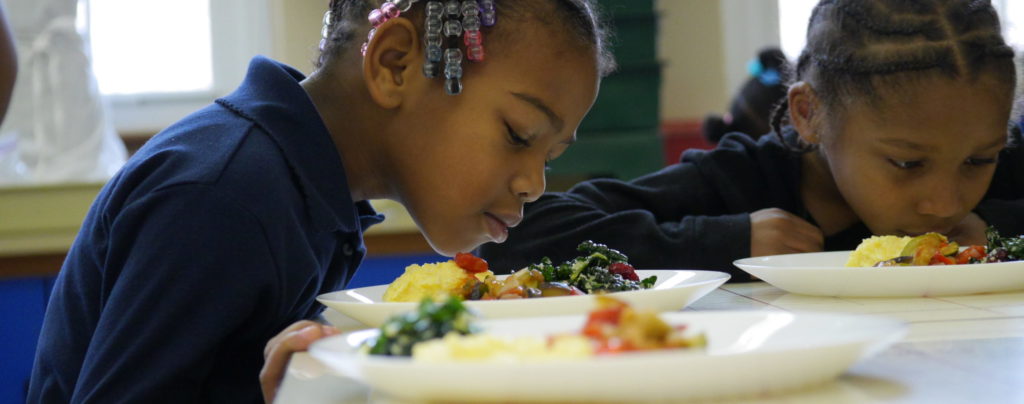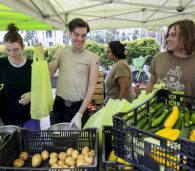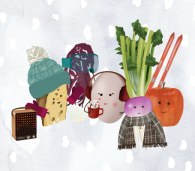FoodPrints’ Approach to Food Education
The FRESHFARM FoodPrints teaching team provides students with hands-on experiences that nurture a sense of curiosity and excitement around fruits and vegetables. Through the FoodPrints program model and curriculum, we encourage students to use their 5 senses as they explore new foods, to consider how food looks and how it makes them feel, and to be involved in all parts of preparing a meal from harvesting to cooking to sharing food.
At the end of the day, eating is an individual’s choice, so rather than pressuring students to eat, we fill the classroom with joy and affirmations of student worth and celebrate their contributions to the meal. Allowing students to make the choice to try the food—or not—builds autonomy and pride in the meal preparation, and allows them to develop food preferences in their own time and on their own terms.
“Allowing children to enjoy a wide variety of food and cultivate a spirit of joy with food and body is the best ‘nutrition education’ we can give them.” – Lauren Anton, RD
Four pillars of FoodPrints’ approach to food education
 Choose Language Around Food Carefully
Choose Language Around Food Carefully
We try not to use the terms “good” and “bad” or “healthy” and “unhealthy” when talking about food. Rather than assigning a moral hierarchy to food that may cause unnecessary guilt and shame around food and eating, we encourage students to reflect on how consuming different foods makes them feel. We have found this practice much more effective in nurturing a positive relationship with food. We also use the phrase “Don’t yuck my yum” to help students see that even if they don’t care for a certain food, they wouldn’t want to spoil the experience for someone else who does enjoy that food.
 Model Positive Food Experiences
Model Positive Food Experiences
We believe that one of the most effective ways to teach nutrition is through modeling – adults preparing and enjoying fresh fruits and vegetables with young children. We encourage eating meals with a variety of nutrient-rich foods (including dessert) and enjoy the ritual of eating together. Students feel so proud when adults and peers eat what they have made and this reinforces the positive experience of working with, and eating, new ingredients.
 Avoid Food Shaming
Avoid Food Shaming
Studies show that food shaming will not lead to people changing their eating habits or food choices. We believe in creating familiarity and appreciation for fresh food through exposure and positive experiences, while meeting kids and families where they are at without judgment. We know that most caregivers strive to provide the best food they can to their families and we believe we should not make anyone feel bad about that.
 Focus on Repeated Exposure & Involvement in Preparation
Focus on Repeated Exposure & Involvement in Preparation
Repetition and involvement may lead to an increased willingness to try the food. Research finds that 8-10 presentations of a new food helps young children openly accept it. We believe it is important to give students of all ages multiple experiences with different preparations of nutritious new foods so they become familiar with and explore them without being pressured to eat the food each time. In our program, even during instances when they choose not to eat it, students help to prepare the food and use their senses to become more familiar with new ingredients.
Nourishing curiosity and excitement empowers young people to develop comfort around fresh produce and gain experience preparing a variety of nutritious meals. Through repeated exposure to new fruits and vegetables in a joyful and low-pressure setting—and never pressuring a student to eat something they aren’t ready for yet—we work to ensure that students associate fruits and vegetables with positive and memorable experiences that they will carry with them into adolescence and adulthood. As a result, we empower our students to make informed food choices for themselves and their families in the future that promote both the health of our bodies and our planet.




